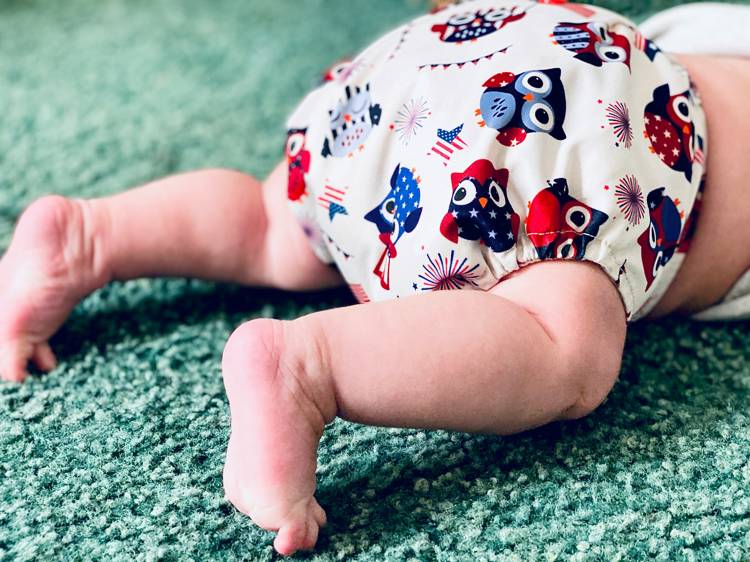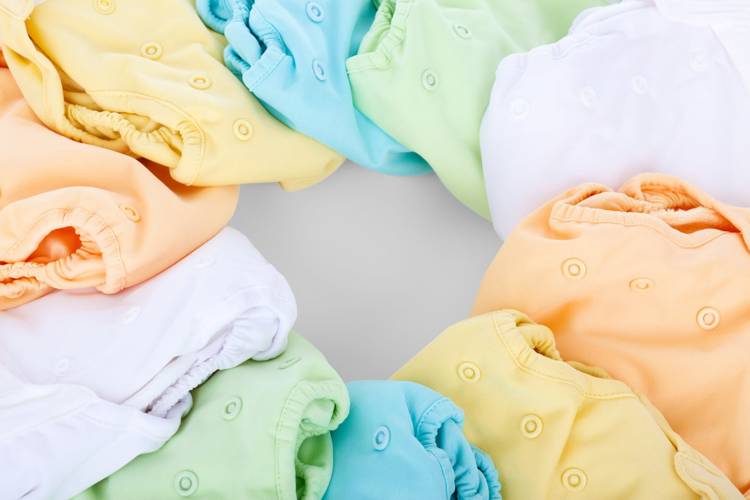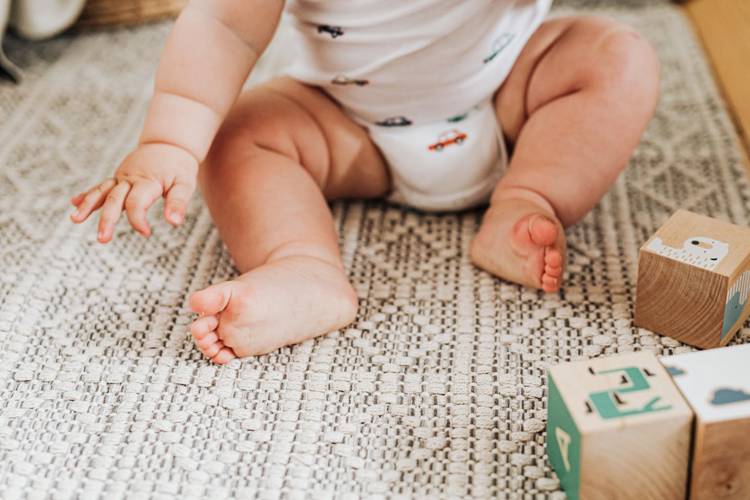Cloth Diapering: Best Practices for Tackling Dirty Diaper Laundry
Bestsellers for Stain Remover & Boosters
Cloth diapering can feel daunting, but with a laundering routine, it's possible to make cloth diapers work for you. In this article, we'll cover everything you need to know about storing and washing cloth diapers. We'll even explain how to tackle stubborn stains and smells that seem determined to stick around. With our helpful tips and tricks up your sleeve, you'll become a cloth diaper laundering pro in no time. Let's get started on making cloth diaper laundry as breezy as possible!
Why Use Cloth Diapers
 Switching to cloth diapers is a choice that many parents consider. If you're on the fence about whether to go the cloth route, understanding the benefits can help make your decision easier. Here's why they might just be the right choice for your family:
Switching to cloth diapers is a choice that many parents consider. If you're on the fence about whether to go the cloth route, understanding the benefits can help make your decision easier. Here's why they might just be the right choice for your family:
- Cost-effectiveness: Over time, cloth diapers can save you a significant amount of money. Unlike disposables that you buy and throw away, cloth diapers can be reused for years and even for more than one child.
Environmental impact: By choosing cloth, you're reducing your carbon footprint. Disposable diapers contribute to landfill waste and take hundreds of years to decompose. Cloth diapers are a sustainable alternative that contributes to less waste.
Gentle on baby’s skin: Many parents find that cloth diapers lead to fewer diaper rashes because they contain fewer chemicals than disposables. The breathable fabric allows air to circulate more freely, keeping your baby's skin drier and less prone to irritation.
Adjustable fit: Cloth diapers come in various sizes and styles, with adjustable snaps or Velcro closures. This means they can grow with your baby, ensuring a better fit at each stage of development.
Cute designs: Let's not forget the fun factor! Cloth diapers come in a wide range of colors and patterns, making diaper changing a bit more enjoyable.
Even if these benefits appeal to you, you might have questions or concerns about laundering. Continue reading to see how it's possible to incorporate cloth diaper laundry into your washing routine no matter your family's needs.
How to Store Dirty Cloth Diapers
 Storing dirty cloth diapers until wash day doesn't have to be a daunting task. With the right approach, you can keep odors at bay and make your laundry routine smoother. The key is to choose a storage solution that works for your space and lifestyle. Here are some effective ways to store those dirty diapers:
Storing dirty cloth diapers until wash day doesn't have to be a daunting task. With the right approach, you can keep odors at bay and make your laundry routine smoother. The key is to choose a storage solution that works for your space and lifestyle. Here are some effective ways to store those dirty diapers:
Dry Pail Method: This involves using a lined container with a lid to store used diapers until laundry day. The benefit of this method is its simplicity and how it minimizes odors without the need for constant washing.
Wet Pail Method: For those who prefer pre-soaking, a wet pail might be the answer. Fill a container with water (and possibly a bit of vinegar) to help pre-treat stains and odors. This method can be more labor-intensive but helps in easing stain removal.
Hanging Wet Bags: These are great for saving space and keeping odors contained. Hang them in your bathroom or nursery for easy access. Wet bags are reusable, making them an eco-friendly option.
Liner Bags in Diaper Pails: If you already have a diaper pail for disposables, simply use a reusable liner bag inside it for cloth diapers. This method offers convenience and uses something you might already own.
No matter which storage method you choose, it's important to wash your storage container or bag regularly to keep things fresh. Also, ensure your chosen method allows for enough air circulation to prevent mold growth.
By selecting the right storage solution for your dirty cloth diapers, you'll find that managing them becomes much less of a hassle. Next, we'll explore how to tackle laundry day efficiently, ensuring those diapers come out clean and fresh every time.
How to Wash Cloth Diapers
 With the right technique, washing cloth diapers it can be as simple as doing a regular load of laundry. The key is to follow a few straightforward steps to ensure your diapers come out clean and ready for another round of wear. Let's break down the process into manageable parts so you can tackle diaper laundry with confidence.
With the right technique, washing cloth diapers it can be as simple as doing a regular load of laundry. The key is to follow a few straightforward steps to ensure your diapers come out clean and ready for another round of wear. Let's break down the process into manageable parts so you can tackle diaper laundry with confidence.
Pre-rinse: Start by running the diapers through a cold water rinse cycle in your washing machine. This step helps remove any remaining waste and prevents stains from setting in.
Hot Wash: After the pre-rinse, add your detergent and run a hot wash cycle. Hot water is effective at sanitizing the diapers and ensuring they are thoroughly cleaned.
Extra Rinse: Following the hot wash, an extra rinse cycle ensures all the detergent is washed out. Leftover detergent can irritate your baby's skin, so this step is crucial.
Drying: Air drying your cloth diapers is the most gentle method and can help extend their life. However, if you're short on time, using a dryer on a low or medium heat setting works too. Just remember to check the manufacturer's instructions to avoid any heat damage.
For those looking to boost freshness or tackle stubborn odors, adding a cup of vinegar to the pre-rinse cycle can work wonders. Vinegar naturally breaks down odors without leaving behind any residue. If you prefer a pleasant scent, consider adding a few drops of essential oil to your wash cycle or using laundry scent boosters that are safe for baby clothes.
Using too much detergent or fabric softener can trap dirt and cause odors to linger. Stick to the recommended amount of detergent and opt for a fabric softener during the final rinse cycle if desired.
By following these steps, washing cloth diapers becomes an easy addition to your parenting routine. Next up, we'll share some tips on tackling those inevitable diaper stains head-on.
How to Remove Cloth Diaper Stains
 Removing stains from cloth diapers doesn't have to be a battle you dread. With the right approach, and a handful of grocery store products you may already have in your pantry or laundry room, you can keep your baby's diapers looking and smelling fresh. Here are some effective strategies for banishing those tough stains:
Removing stains from cloth diapers doesn't have to be a battle you dread. With the right approach, and a handful of grocery store products you may already have in your pantry or laundry room, you can keep your baby's diapers looking and smelling fresh. Here are some effective strategies for banishing those tough stains:
Sun Bleaching: Believe it or not, the sun is one of your best allies in fighting diaper stains. After washing, lay the diapers out in direct sunlight. The sun's natural bleaching effect will help fade stains without the use of harsh chemicals.
Baking Soda Paste: For targeted stain treatment, make a paste with baking soda and water. Apply this directly to the stain before washing. Baking soda is gentle on fabrics but tough on stains, making it ideal for sensitive materials like cloth diapers.
Lemon Juice Soak: Lemon juice acts as a natural bleach. Soak the stained diaper in a mixture of lemon juice and water for an hour before washing. This method is especially good for lightening old or set-in stains.
Enzyme Cleaners: Enzyme-based cleaners break down proteins in organic stains (like those found in diapers). Apply according to the product instructions before tossing the diaper in the wash. These cleaners are effective yet gentle enough for frequent use.
Oxygen Bleach: Oxygen bleach is a safe alternative to chlorine bleach and can be used on most colors and fabrics. Add it to your wash cycle according to package directions to help lift stubborn stains.
It's also helpful to know that treating stains as soon as possible increases your chances of removing them completely. However, avoid using chlorine bleach regularly as it can weaken fabric fibers over time and reduce the lifespan of your cloth diapers.
By incorporating these stain-removal techniques into your laundry routine, you'll find that keeping your cloth diapers stain-free is easier than you might think. Plus, you'll have peace of mind knowing you're using safe methods that won't irritate your baby's skin or harm the environment.
FAQ

How many cloth diapers do I need to start?
The number of cloth diapers needed can vary depending on the age of your baby and how often you plan to wash them. On average, newborns might require 10-12 diapers per day, while older babies may need 6-8. Starting with a stash of 20-24 diapers allows for a comfortable rotation between washes.
Can cloth diapers be used overnight?
Yes, cloth diapers can be used overnight. Adding extra absorbent layers or using diapers specifically designed for overnight use can help prevent leaks and keep your baby comfortable through the slumber.
Are cloth diapers suitable for newborns?
Cloth diapers are suitable for newborns and come in sizes and designs that accommodate the smallest of bums. Look for newborn-specific cloth diapers or ones with adjustable sizes to ensure a snug, leak-proof fit.
How long can a cloth diaper be worn before it needs to be changed?
Cloth diapers generally need to be changed every 2-3 hours during the day. However, with added absorbency, they might last a bit longer. Overnight diapers should be designed to last 8-10 hours with proper absorbency adjustments.
Can cloth diapers cause diaper rash?
Cloth diapers can actually lead to fewer cases of diaper rash owing to their breathability and lack of chemicals compared to disposables. Proper cleaning and changing diapers regularly are key to preventing rashes.
How do I know if a cloth diaper fits properly?
A proper-fit cloth diaper should be snug around the waist and legs without leaving red marks or allowing gaps where leaks can occur. Adjust the snaps or Velcro for a customized fit as your baby grows.
Can I use standard laundry detergent to wash cloth diapers?
While you can use standard laundry detergent, it's recommended to choose a detergent that is free of fragrances, dyes, and fabric softeners, which can decrease the absorbency of cloth diapers and irritate baby's skin.
How do I deal with solid waste in cloth diapers?
Solid waste should be disposed of in the toilet before storing or washing the diaper. Liners can be used within cloth diapers to simplify the removal of solid waste.
Is it necessary to use a diaper liner with cloth diapers?
Diaper liners are not necessary but can make handling solid waste easier and can add an additional layer of protection against stains.
How much water is needed to wash cloth diapers effectively?
Washing cloth diapers effectively does not require more water than a standard load of laundry. It is important, however, to use enough water to fully submerge and clean the diapers in the washing machine.
Will sunlight fading impact the effectiveness of cloth diapers?
Sunlight fading does not affect the effectiveness of the diaper's absorbency. It is purely a cosmetic change and is a natural and eco-friendly way to help remove stains.
Can cloth diapers be passed down to younger siblings?
Cloth diapers can certainly be passed down to younger siblings, making them an economical and sustainable choice for families with multiple children. Regular inspection for wear and proper sanitation are recommended.
What should I do with cloth diapers that are no longer absorbent?
Diapers that have become less absorbent can often be revived by stripping them, a process that removes buildup from detergent and natural oils. If they cannot be restored, consider repurposing them as cleaning cloths.
How often should cloth diapers be stripped?
Stripping is only necessary when diapers have issues with absorbency or odor that regular washing does not resolve. For many, this might be as infrequently as every few months or even less.
Is there an ideal water temperature for washing cloth diapers?
A hot wash cycle is ideal for thoroughly cleaning and sanitizing cloth diapers. However, always check the diaper's care instructions as some materials may have specific temperature limits to prevent damage.
Safeway Buying Guide

Clorox Original Scent 2 For Colors 3 In 1 Laundry Additive - 66 Fl. Oz.
Clorox 2 for Colors 3-in-1 Laundry Additive is an ideal product for removing tough everyday laundry stains, removing odors and brightening colors all without harming the color of your fabric. The bleach-free formula is safe for all loads and fabrics, while also containing 2 times the color brightening power than detergent alone. Additionally, this product can remove visible dirt like mud and stains as well as small, surface-level dirt that’s invisible to the naked eye!
- Original Scent: Customers appreciate the fresh and clean scent of this product.
- Color Protection: Users have praised its ability to maintain the vibrancy of their colored clothes.
- 3-in-1 Functionality: Consumers love the multi-purpose aspect, acting as a color protector, stain remover, and brightener.
- Large Size: At 66 Fl. Oz., customers find it a great value for the size and it lasts longer.
- Clorox Brand: Many customers trust the brand, which is known for its quality cleaning products.
- Easy to Use: Users noted that it's easy to incorporate into their regular laundry routine.
- Effective Stain Removal: Numerous reviews highlighted its effectiveness in removing stubborn stains.
OxiClean Odor Blasters Versatile Stain Remover - 3 Lb
OxiClean Odor Blasters Versatile Stain Remover is a great product for getting tough stains and odors out of laundry and other surfaces. It contains the same oxygen-based stain removal power as the original OxiClean Versatile Stain Remover, but also has a special formulation to attack tough odors like musty towels, body odor, and sweat. It is chlorine free and color safe, works in all washing machines, and comes in a convenient 3 lb. package that delivers 57 regular loads. It is also certified renewable energy with 100% certified renewable electricity.
- Effectively removes stains: OxiClean Odor Blasters has been praised for its ability to effectively remove a variety of tough stains.
- Eliminates odors: Many users have reported that this product works excellently in eliminating unpleasant odors, not just covering them up.
- Versatile use: Users love the versatility of this product. It can be used on a wide variety of items, from clothing to carpets.
- Color-safe: A significant number of reviews have mentioned that this product is safe for colored fabrics, protecting them from fading.
- Easy to use: Customers appreciate the easy-to-follow instructions and simplicity of use, making laundry chores less daunting.
- Great value for money: The 3lb package offers a large amount of product, providing great value for the price paid.
- Safe on sensitive skin: Several users with sensitive skin have reported no irritation after using this product, highlighting its skin-friendly formula.
Lysol Laundry Sanitizer Free & Clear - 90 Fl. Oz.
Lysol Laundry Sanitizer Free & Clear is an effective sanitizing product that eliminates 99.9% of bacteria and viruses, including the Covid-19 virus. It contains 0% bleach, is free from fragrance and dyes, and is gentle on most fabrics. It's easy to use in both standard and HE machines, making it the perfect solution for sanitizing laundry safely and effectively. Plus it's tested and proven to kill the Covid-19 Virus in 5 minutes during pre-soak conditions.
- Kills 99.9% of bacteria: Customers appreciate that Lysol Laundry Sanitizer effectively eliminates a high percentage of bacteria, making it a trusted choice for maintaining cleanliness.
- Free & Clear formula: Users love the product's Free & Clear formula, which is free from fragrances and dyes, offering a great option for those with sensitivities or allergies.
- Doesn't damage fabrics: This laundry sanitizer is praised for its gentle action that doesn't cause any harm to fabrics, preserving their quality and longevity.
- Large volume: The 90 Fl. Oz. size is popular among customers as it provides great value for money and lasts for many laundry cycles.
- Effective in cold water: Many reviewers commend the product's efficiency even in cold water, making it energy-saving and eco-friendly.
- Safe for all machines: Users appreciate that this product is suitable for use in all washing machines, including HE (High Efficiency) models.
- Easy to use: Customers find Lysol Laundry Sanitizer easy to use, adding convenience to their laundry routine.



























